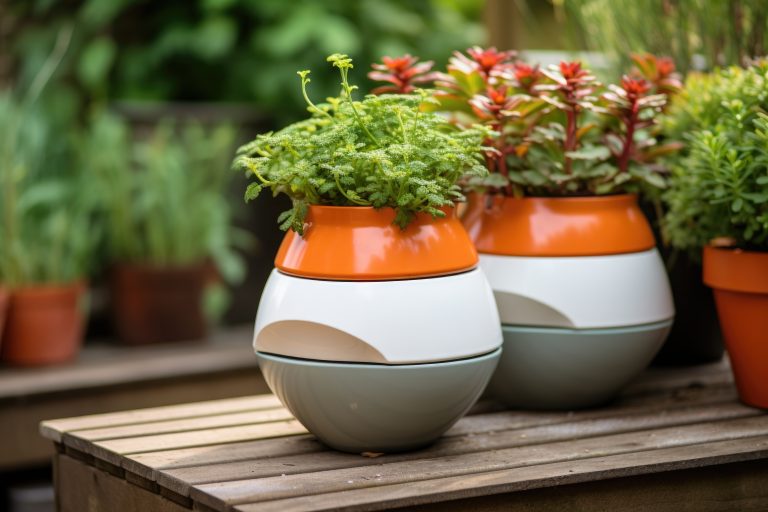Gardening enthusiasts and professional horticulturists alike have long struggled with the age-old challenge of keeping their plants hydrated without over-watering or under-watering. While Mother Nature effortlessly strikes this balance outdoors, patio, or indoor plants require a more hands-on approach.
Self-watering pots are designed to automatically provide plants with the right amount of moisture they need, preventing the root rot that often results from excess moisture or the drought stress from inconsistent watering. Maze’s decorative self-watering pots and other designs merge functionality and aesthetics.
As urban gardening grows in popularity and space becomes a luxury, these pots are an excellent solution for those who may not always have the time to tend to their plants daily.
What are Self-Watering Pots?
Self-watering pots, or sub-irrigated planters, are containers designed to water plants from the bottom up.
At its most basic, the system involves two pots: one inside the other. The outer pot holds water, while the inner one holds the plant and soil. Wick-like structures or platforms connect the two, drawing water into the soil as needed.
The design ensures the soil remains moist but not waterlogged. Plants naturally draw the amount of water they require, promoting healthier root growth and reducing the risk of root rot. For gardeners, this system means less frequent watering and healthier plants.
As more individuals live in environments with limited outdoor space, the demand for solutions that can sustain plants with minimal intervention has grown.
Reservoir Systems
The water reservoir is the primary component of any self-watering pot. This chamber is located at the bottom of the pot and stores water for future use. The reservoir size varies between different pot designs but serves the same fundamental purpose.
When water is poured into the pot, excess water drains into the reservoir, preventing the plant’s roots from sitting in standing water. This is crucial because continuously waterlogged conditions can lead to root rot and other plant diseases.
Water in the reservoir doesn’t stagnate. The soil, through capillary action, draws water upwards when needed. This ensures that plants receive consistent water, optimizing growth conditions.
The Wicking Mechanism
The wicking mechanism bridges the reservoir and the plant’s roots. Typically made of absorbent materials like felt or fabric, these wicks are submerged in the reservoir and extend into the pot’s soil.
As soil dries out from the top, the capillary action pulls water from the reservoir through the wick, ensuring the soil remains moist. The process is natural and mirrors how plants draw water from the ground in nature.
It’s essential to use a potting mix designed for self-watering pots to ensure optimal performance. These mixes provide the right balance of aeration and moisture retention to work in tandem with the wicking mechanism.
Overflow Mechanisms
Many self-watering pots feature overflow mechanisms to prevent over-filling and the possibility of waterlogging. These outlets or holes allow excess water to escape once the reservoir reaches its maximum capacity.
The overflow mechanism protects plants from drowning by ensuring that the reservoir cannot be overfilled. This design detail is particularly useful for gardeners who might not be familiar with the specific water needs of their plants.
In addition to safeguarding plant health, overflow mechanisms prevent messy spills and water wastage, making self-watering pots an environmentally friendly choice.
Monitoring Water Levels
Knowing when to refill the reservoir is vital for the continued success of self-watering pots. Many designs come equipped with water level indicators, showing gardeners at a glance when it’s time to add more water.
These indicators often function as floats. When the water level is high, the float rises, and as the reservoir depletes, it gradually sinks. By monitoring these indicators, gardeners can ensure their plants never run out of water.
Consistent water supply is a cornerstone of plant health. With water level indicators, gardeners can easily maintain this consistency, reducing the margin for error in plant care.
Benefits for Different Plant Types
Not all plants have the same water requirements. Succulents, for instance, require far less water than a fern. However, self-watering pots can cater to a wide range of plants, thanks to their adjustable nature.
For plants that thrive in drier conditions, gardeners can simply let the reservoir run dry more often, ensuring the soil isn’t constantly moist. Conversely, for those plants that enjoy consistently damp soil, keeping the reservoir filled will meet their needs.
The versatility of self-watering pots means they are suitable for various plant types, from herbs and flowers to larger plants. Regardless of a plant’s specific needs, there’s likely a self-watering pot that’s just right.
Maintenance and Care
Like any gardening tool, self-watering pots require occasional maintenance to ensure they function optimally. Over time, minerals from water can build up in the reservoir, potentially clogging the wicking system. Regularly cleaning the reservoir and checking the wick for blockages can prevent this.
It’s also essential to refresh the potting mix occasionally. As the mix breaks down over time, its capacity to draw water efficiently can diminish. Replacing the soil every few years can help maintain the pot’s effectiveness.
Lastly, while self-watering pots significantly reduce watering frequency, they don’t eliminate the need for other plant care tasks. Regularly checking for pests, pruning, and feeding with appropriate plant food remains crucial for plant health.
The Bottom Line
Self-watering pots provide an innovative solution to the age-old challenge of plant hydration. Through their reservoir systems, wicking mechanisms, and overflow safeguards, these pots consistently ensure plants receive the right amount of water.
Suitable for various plant types and requiring minimal maintenance, they’re a boon for both seasoned gardeners and novices alike. As urban living continues to rise, tools like these become invaluable in bringing a touch of nature indoors.

